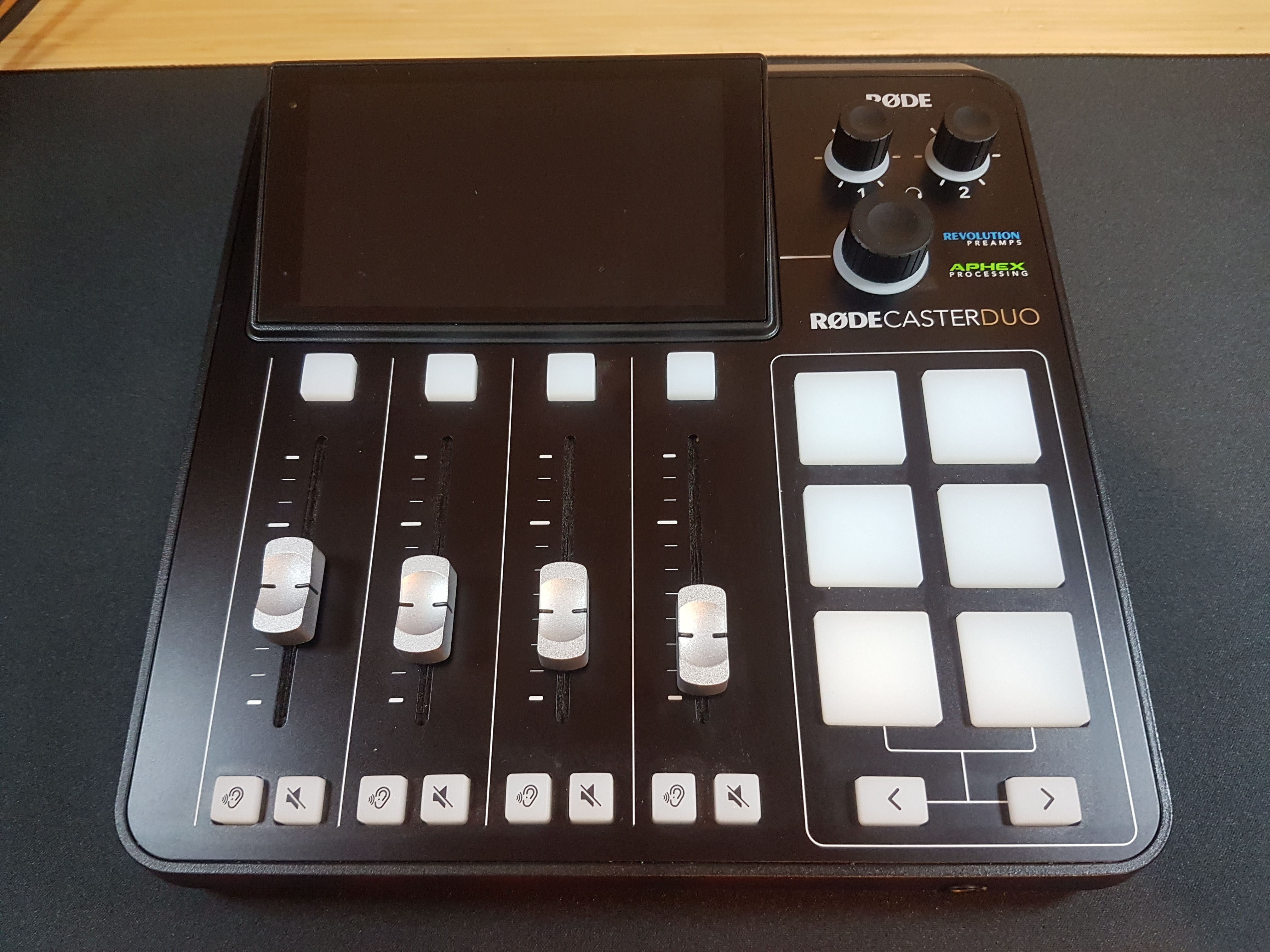Tom's Hardware Verdict
The Rodecaster Duo is a superb mixing interface that combines audio mixing and macro pad interaction for a streaming/podcasting solution perfect for smaller operations.
Pros
- +
Great sound quality and onboard controls
- +
Plenty of connectivity
- +
Colorful and customizable macro pad
Cons
- -
Expensive
- -
Only comes with one USB-C cable
- -
Configuring has a bit of a learning curve
Why you can trust Tom's Hardware
Rode's Rodecaster Duo is an audio-focused streaming deck that aims to fill the needs of users who require a professional audio production solution (for recording instruments, vocals, podcasting, or other streaming), but who don't need something as big and complicated as the Rodecaster Pro II. The Rodecaster Duo offers a similar range of features as the Rodecaster Pro II, but it's much more compact, with fewer faders, macro pads, and audio inputs.
It includes the same quad-core audio engine, two Revolution preamps, APHEX DSP, and a TRRS headphone input on the front of the unit. All functions can be viewed and controlled on the built-in 5.5-inch HD touchscreen, which offers light haptic feedback. If the icons on the screen are too small for you to operate with a finger, you can also tweak all settings using the rotary encoder knob for more precise control.
Design of the Rodecaster Duo
The Rodecaster Duo is nice and compact — especially considering how much tech is stuffed inside. It features the same overall aesthetic and color scheme as its big brother, the Rodecaster Pro II, it's just smaller. It won't take up as much space on your desk or in your bag, so it's a great travel option for streamers and podcasters on the go.






The Rodecaster Duo is housed in a sturdy black plastic chassis that measures 9.2 inches (235mm) long by 8.8 inches (225mm) wide, and is 2.9 inches (76mm) high. It has a 5.5-inch screen, which is slightly tilted for easier viewing, as well as metal sliders, control knobs, and rubber buttons.
You will no longer need to have a second screen dedicated to monitoring your volume levels, nor will you have to worry about not being able to see if your microphone is outputting volume, thanks to the Rodecaster Duo's delightful, bright, 5.5-inch high-definition touchscreen. You can control the Rodecaster Duo entirely from this screen — you can do everything from managing the volume faders on the audio channels to making on-the-fly sound bytes for your macro pads by recording and editing input sound sources in seconds (you'll then have them at your disposal for live stream or podcast). This is probably one of my favorite, and most used, features on the Rodecaster Duo.
There are three control knobs on the Rodecaster Duo: two for headphone volume and a third for controlling audio selections on the screen. Pressing the knobs activates a selection switch, and turning them either lowers or raises an attribute or moves a menu selection left or right. It’s a very intuitive control menu scheme — it takes no time to pick up naturally.
The Rodecaster Duo has seven audio channels — four are able to be assigned to the gorgeous, smooth sliding faders, while the other three are virtual. The virtual channels can be accessed on the touchscreen, or via the rotary encoder knob. The four physical faders are broadcast-quality, with individual mute/listen buttons so you can silence or prioritize channels quickly.
Get Tom's Hardware's best news and in-depth reviews, straight to your inbox.
The most colorful part of the Rodecaster Duo is the macro pad, which has six programmable macro buttons. There are two small buttons under the macro buttons, which let you rotate through eight "pages" of buttons — for a total of 48 macro buttons.
I personally like the disco-lighting look of the Rodecaser Duo, but if that's not to your taste, you can tone it down by reducing the brightness of the colored lights — or even turning them off, if you prefer. The Rodecaster Duo is highly customizable and compact, and it's been able to do anything I've wanted it to do so far — and it should work pretty well for a variety of users, no matter what features or functionality you need.
Specs
| Frequency Range Mic Inputs | 20Hz - 20kHz |
| Frequency Range Monitor Outputs | 20Hz - 20kHz |
| Analog Audio Inputs | 2 x XLR Combo Jacks |
| Digital Audio Inputs | 2 x USB-C |
| Analog Audio Outputs | 2 x 1/4 -inch headphone outputs, 2 x ¼-inch line (L&R)outputs, 1 x 3.5 TRRS headset jack, |
| Preamplifier Gain Range | 0 - 76dB |
| Bit Depth | 24-bit |
| Sample Rate | 48kHz |
| Network Connectivity | WiFi 802.11g/n/ac 2.4GHz and 5GHz, Ethernet 100/100 |
| Internal Storage | 4GB (SMART pads) |
| Weight | 2.49lbs / 1131g |
| Dimensions (H x W x L) | 76 x 225 x 235 mm / 2.9 x 8.8 x 9.2 inches |
| MSRP | $499 / £540 |
Features and Software of the Rodecaster Duo
The Rodecaster Duo has a few features that make it stand out. First, there’s the excellent audio hardware inside the unit: the Revolution Preamps, which have = a gain range of 0-76dB and step up the audio quality of your microphone, an APHEX DSP for fine-tuning your sound the way you want it, and the ability to connect a several audio devices to this mixing interface. Second, the programmable macro pads give you the functionality of a Stream Deck or similar device. Finally, the included screen lets you visually keep track of everything that’s going on without needing to set up a second monitor. I found this especially useful for streaming, but it should be just as functional for podcasting — and if you're hooked up to a phone or tablet, a dedicated screen is even more valuable.


The Rodecaster Duo also features wireless connectivity — the console can update firmware wirelessly and it also has wireless receivers for connecting wireless microphones. It features Bluetooth for hooking up mobile devices, which can then be added as audio channels. Not everyone is going to be running a mobile setup, but it's nice that the Rodecaster Duo is so versatile and can amalgamate so many different hardware and software solutions into one package. (There's even an option to record onto microSD cards, thanks to an onboard slot.)
On the rear of the Rodecaster Duo is where all the action takes place — this is where you'll find all connections. There are 2 x Neutrik combo XLR inputs for connecting microphones, instruments, and line-level devices, 2 x 1/4-inch headphone outputs, 2 x 1/4-inch line (L&R monitor) outputs, 2 x USB Type-C, 1 x Ethernet, 1 x microSD Card slot, and a power port.
You can run the Rodecaster Duo without any software, but I recommend using it with its companion software, Rode Central, for the best experience. While you can configure pretty much everything on the Rodecaster Duo itself, having the ability to tweak and tune everything (from the DSP to adding sound files) using the companion app on a bigger screen makes life so much easier.
Another piece of software that you might need, if you want to control programs such as OBS or Streamlabs, is a Midi interface controller — so that the Rodecaster Duo’s macro pads can communicate with your chosen software and execute commands. This is something you'll need to research individually, as you'll need different programs depending on your setup and what tasks you're looking to perform.
Bottom Line
I love this device: Not only has it freed up a bunch of resources on my computer, it’s also improved the quality of my content production thanks to its excellent sound quality and ability to control so many things with the touch of a button or slider. I no longer need a second monitor to keep an eye on my sound levels or check that things aren’t muted, nor do I have to tab out of applications or games to tweak audio levels — I have no need for additional peripherals such as a Loupedeck. Being able to make voice clips and sound effects on the fly is a neat feature, and it really adds to the fun you have with friends on Discord (or with your audience, if you’re a streamer or content creator).
The Rodecaster Duo, similar to the more complex Rodecaster Pro II, comes with somewhat of a learning curve — you'll need to spend some time getting to know it if you want to get the most out of the device. There are so many things to tweak and configure that I’ve spent hours trawling through forums and videos on how to configure everything, from setting up the macro pads to separating application audio for mixing channels. But once you set up the device for your situation, it can really help streamline your content creation.
The Rodecaster Duo isn't cheap, unfortunately — while it may save you some space, because you'll only need one device instead of several pieces of tech, $499 is still a pretty big investment. Plus, it's definitely very audio-focused — if you're not as interested in the Duo's audio quality, something like the Elgato Stream Deck+ will be more versatile.

Stewart Bendle is a deals and coupon writer at Tom's Hardware. A firm believer in “Bang for the buck” Stewart likes to research the best prices and coupon codes for hardware and build PCs that have a great price for performance ratio.

